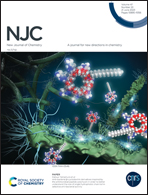A 3D paddle-wheel type Cu(ii)-based MOF with pcu topology as an efficient photocatalyst for antibiotics photodegradation†
Abstract
Metal–organic frameworks (MOFs), a sub-class of coordination polymers, are assorted multidimensional materials that could be employed as photocatalysts for decomposition of antibiotics present in wastewater discharge. Herein, a new three dimensional (3D) paddle-wheel type Cu(II)-based MOF [Cu2(BDC)2(bb)] (1) (BDC = benzene 1,4-dicarboxylate; bb = 4,4′-bis(imidazolyl)biphenyl) has been synthesized and characterized. MOF 1 possesses 3D pcu topology and exhibits semiconducting properties with a band gap of 2.34 eV and hence effectively catalyzes the photodegradation of antibiotics under UV light irradiation. The photocatalytic results suggest that MOF 1 exhibits the best photocatalytic activity toward nitrofurantoin (NFT) amongst three antibiotics, viz. chloramphenicol (CAP), metronidazole (MDZ), and nitrofurantoin (NFT) investigated herein. The effects of initial solution pH, concentration of antibiotic, and photocatalyst dosage have been monitored for the photocatalytic performance analysis of 1. Under the optimal reaction conditions, ∼92.04% photodegradation of NFT has been observed at pH 5, at 10 ppm concentration of NFT and at 50 mg photocatalyst concentration in a 100 min time span. The radical trapping experiments suggest that O2˙− is the main active species that catalyzes the photodecomposition. The possible mechanism for the nitrofurantoin (NFT) degradation of 1 is proposed using density of states (DOS) calculations and Hirshfeld surface analysis.



 Please wait while we load your content...
Please wait while we load your content...